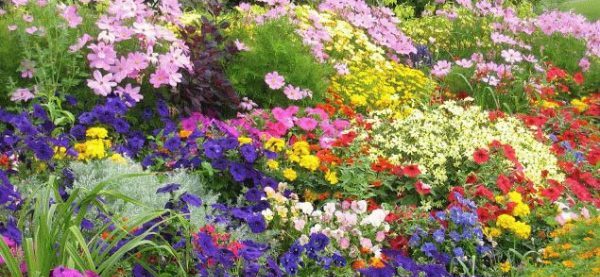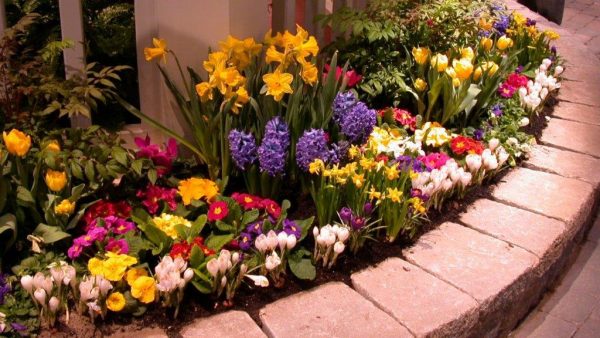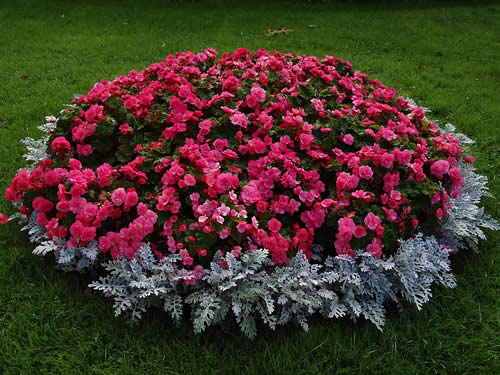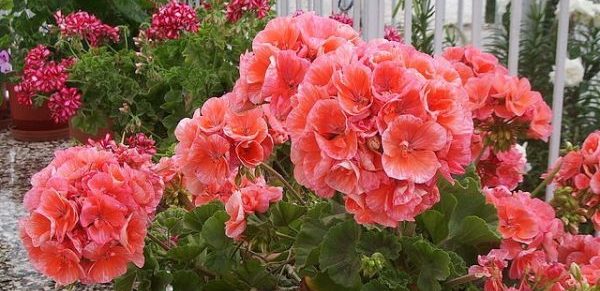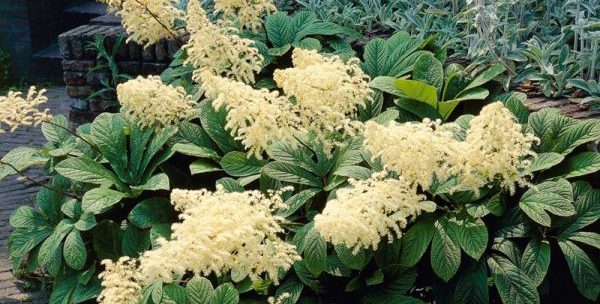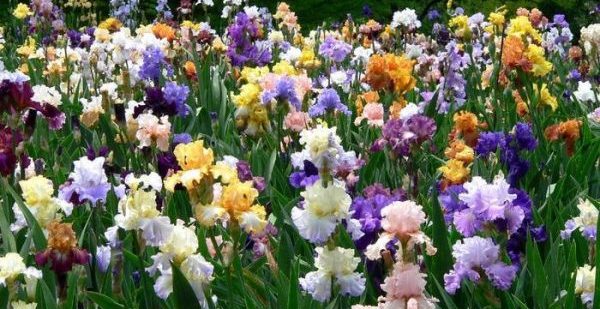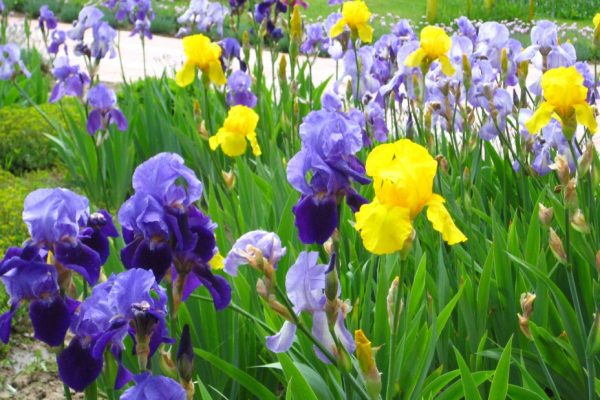How to choose a combination of flowers in a flower bed: possible options and schemes
Content
What are the flower beds
Depending on the location on the site, the flower beds are central, for example, with roses, and lateral (may be with natural cereals). In accordance with this, their shape, size, framing are selected, and also take into account how the flowers are combined:
- Regular (have a regular geometric shape with patterns symmetrically converging to the center). To create them, low-growing flowers of the same height and flowering period are planted. As a rule, they are combined with the style of a country house.
- Irregular (for example, with roses, formed from frost-resistant picturesque perennials planted in groups).
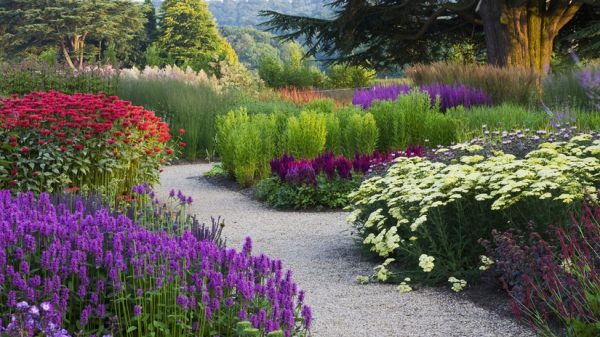
- Raised (flower arrangements are created in enclosing structures
- Wooden, concrete, etc.). These include a flowerpot.
- Vertical (using a container for flowers, towering above the ground). The basis is liana-like plants.
- Monochrome (most often from one type of flowers of the same shade - for example, roses).
- Mixborders (they have an irregular geometric shape, perennials are adjacent to annual plants). Continuous bloom throughout the season.
Video "Examples of how to pick flowers"
Demonstration video with examples of color matching for a flower bed.
How can you combine flowers
Beautiful flower gardens are a skill that takes into account all the components of the process of their creation: from the characteristics of the planted plants to how this or that flower is combined with others and in general with the style of the site. First of all, you need to decide what effect you want to achieve. For example, marigolds or nasturtiums will add sunshine to the flower garden, forget-me-nots, etc. With roses, the site will look solemn. If you strive for sophistication, white lilies will help you.
To create a monochrome composition in a small flower garden with shades similar or contrasting in the color spectrum, you can choose several types of plants of different heights and shapes: for example, high phloxes - in the center, low pansies - at the edge, between them - hosta. The main thing is to correctly combine. A beautiful flower garden is obtained from one type of flowers in different shades. For example, the main element is irises, which bloom in late spring. It is advisable not to combine anything else with roses. In addition, it should be borne in mind that yellow-red and orange shades (for example, marigolds) accentuate the flower garden, calm blue-blue and green - background for bright colors. Neutral white creates a transition, smoothing out contrasts.
When creating irregular beds, it is best to plant one or two attractive flowers that will not wilt throughout the season while other plant groups change. An example is this option: a badan with wide green leaves that turn red in autumn, a daylily, a hosta. The border is a saxifrage. Contrasting compositions look unusual on large flower beds of clear shapes without borders. For example, pink and white geraniums are interestingly combined with a red grackle (hosta is also possible).A flower garden with roses looks exquisitely interspersed with tall decorative grains.
Consider a mix of the most popular plant species. Lilies. Usually planted in groups: separate islands of lilies of different varieties. They are often combined with other perennials. Assorted lilies, planted in one group in two or three tiers, look very beautiful.
For example, in the foreground there are undersized lilies forming a lush rug (“Asian women” that bloom first). The next tiers are tall oriental lilies. It is advisable to separate the tiers with other plants (undersized). It is possible to combine lilies in a flower bed with peonies that bloom earlier and have lush foliage - the background. Moreover, lilies will look beautiful both in front of the peonies and behind them. It is best not to plant lilies next to roses. Lilies should not coexist with tulips, since they are affected by the same diseases and pests.
Host. The perennial hosta perfectly decorates any flower bed. In addition to growing in any conditions, the hosta is well adjacent to almost all plants. Most often, in flower beds, the host plays a background role. Hosta harmonizes well with peonies, astilbe, as well as small-leaved plants.
The medium-sized hosta with beautiful large leaves in the center of the carpet bed retains its attractiveness for many years and can act as a "step" connecting the high and low tiers of the flower garden. For example, we plant a fern in the back row, on average there will be a hosta, and in the lower row there will be a petunia or other undersized perennial.
Roses. Self-sufficient beautiful flower. The main condition: roses should be combined with flowers and leaves of blue, blue, lilac, silver shades (delphinium, clematis, veronica, etc.). Standard roses are in harmony with soothing annuals (lobelia, gypsophila) and are not combined with bright annuals (salvia, geranium). You can make a flower bed where roses will coexist with phloxes - close shades (burgundy, pink) look especially good, but you can use contrasting ones.
Roses also look great next to lavender and yarrow. Marigolds have a beneficial effect on roses, repelling pests. It is important to consider that roses are suitable for rectangular flower beds. In alliance with decorative grasses (fescue, evergreen oats, etc.), roses emphasize their grace. Of the bulbous with roses, only white lily is harmoniously combined.
Geranium. Geranium looks organically in mixborders. Some of its varieties grow very quickly, displacing neighboring plants that do not differ in such a growth rate. Plugs geraniums and weeds. Emitting a spicy aroma in the heat, geranium with the help of phytoncides drives away pests from neighbors.
Effectively fills the space in the flowerbed. Combines with many plants. There are such options for flower beds where geranium is used:
- decorative bow, garden lupine, majestic geranium;
- Geranium Andris and Hosta;
- in the center of the mixborder - wormwood with trimmed boxwood, further - groups of decorative onions, verbena, multicolored and yarrow, along the edge - geranium, cuff and cinquefoil;
- peony lactic-flowered, soft cuff, geranium.
Irises. Irises with large flowers are wonderful for creating a monochrome flower bed, complemented by decorative cereals. For decorating flower beds, irises of one or more varieties of various colors are used. Blue or white irises and bright scarlet oriental poppy contrast beautifully. The same yellow shade of irises and lily, in combination with incense, look spectacular.
Irises ideally coexist with lavender, rogersia. A bright composition will come out if irises planted in groups are supplemented with phlox, saxifrage, interspersed with bulbous - daffodils, tulips, lilies. At the same time, the perennials used should not be higher than the irises, otherwise they will shade them, they should not be planted with roses.
Marigold.Any types of flower beds will be decorated with marigolds, driving away all kinds of pests from neighbors. Low-growing varieties are used in borders or in combination with tall ones in monochrome flower beds. In turn, tall marigolds look good as a middle or background.
An interesting combination in planting white-flowered (seaside lobularia, fragrant tobacco) and yellow-flowered plants (marigolds) with silvery leaves. And if you combine yellow zinnias, sunflowers, titonia, dahlias and marigolds, a very effective composition will come out. Against the background of purple flowers of powdery sage and heliotrope, marigolds "shine" with the sun. Marigolds perfectly coexist with phlox, asters, geraniums.
Key rules in the design of a flower garden
The flower garden is arranged in accordance with certain rules:
- combine plants in color, leaf shape;
- flowers are planted different in shape and close in color (large ones wonderfully harmonize with small and decorative cereals);
- take into account the flowering time: plants with different flowering periods are selected so that voids do not arise, flowers that fade quickly, it is advisable to plant one by one between other plants;
- pay attention to the height of plants: the center or background is high, the border is undersized or creeping;
- to know about "sprawling" perennials, which are given enough space, and annuals are planted in the voids, taking into account their growth rate;
- planting density: competently created flower beds - with a rare planting density in the center and dense - along the edge, undersized flowers on the border should be covered with a "carpet";
- correctly combine plants depending on the requirements for agricultural technology (watering, soil type, etc.): they must be identical in terms of care for them;
- avoid planting many different types of flowers.
Flower planting scheme
There are several planting schemes:
- monochrome (using different shades of the same color, for example, dark roses);
- contrasting (created with clean tones located opposite each other in the color wheel), for example, irises can contrast with peonies and lilies;
- contiguous tones (most often this is a landing of 2-4 shades adjacent in the color wheel; the transitional element is white).
Thinking over the design of the flower garden, taking into account the agricultural features of the planted plants, their combination with neighboring ones, plus imagination, help to create unique flower beds.
Video "Original varieties of flowers"
Video selection of original varieties of flowering plants.

